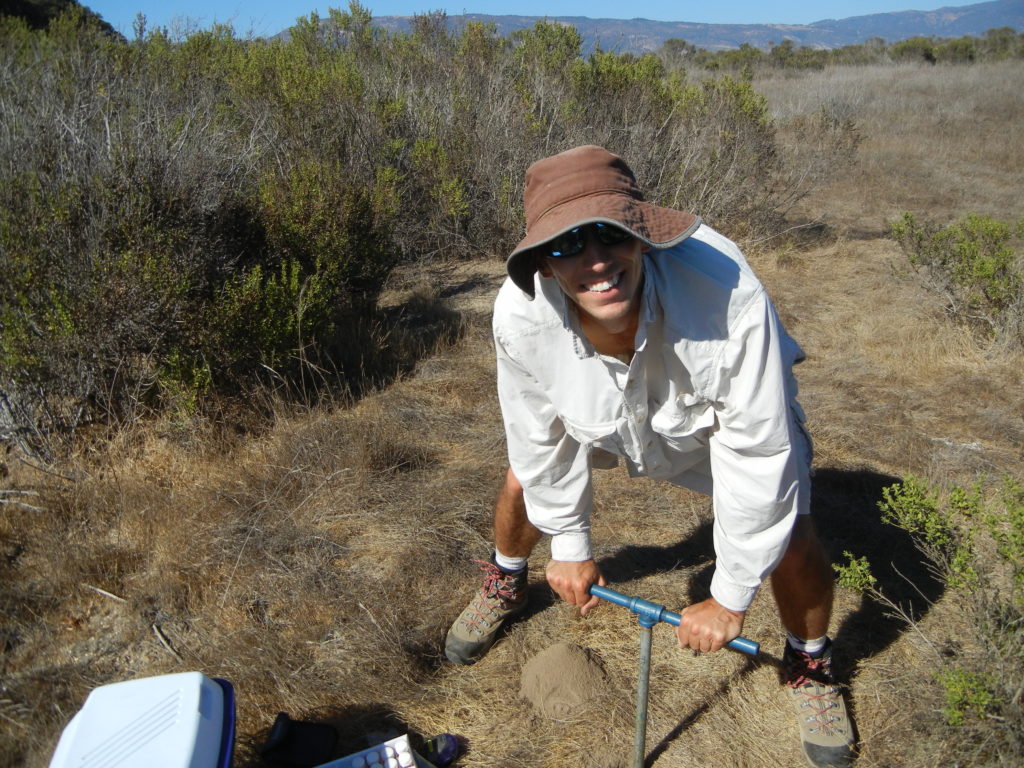
The overarching research questions that pique my curiosity are the following:
- How does plant water use differ across species, populations, and ecosystems?
- What are the greater ecological implications of differential water use among plants?
- How can we effectively prepare instructors to teach student-focused courses and implement scientific teaching practices in the classroom?
**Jump to full publications list**
How does plant water use differ across species, populations, and ecosystems?
I am fascinated by plant adaptation to water limitation and the diverse mechanisms by which plants take up and conserve water resources. Currently, I am investigating water use and productivity across switchgrass genotypes and populations as part of the Great Lakes Bioenergy Research Center. I am interested in the variation in stomatal morphology and behavior and how it relates to local adaptation of the various populations.
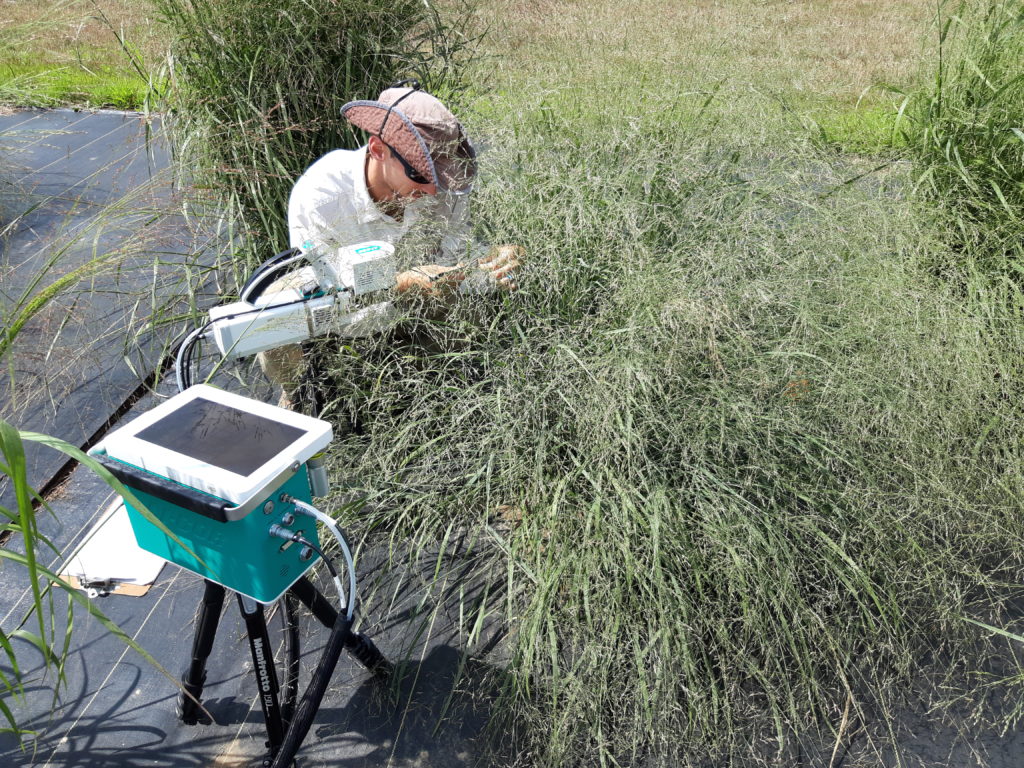
I have explored plant water use primarily in the semi-arid ecosystems of California during my PhD thesis. There I investigated how native shrubs take up fog water and how this water use changes over time. I have continued working with students (* = undergraduate authors) on how water uptake varies across across sites and species.
Relevant publications:
Berry, Z. C., Ávila-Lovera, E., De Guzman, M. E., and K. O’Keefe, and N. Emery. 2021. Beneath the
bark: woody stem water and carbon fluxes and the implications for stem-atmosphere exchange and
plant function. Frontiers in Forests and Global Change 4.
Lott, S.* and N. Emery. 2021. The effect of leaf morphological traits and acidic wet deposition on hydrophobicity. RURALS.
VanWallendael, A., Soltani, A., Emery, N. C., Peixoto, M. M., Olsen, J., & D. B. Lowry. 2019. A Molecular View of Plant Local Adaptation: Incorporating Stress-Response Networks. Annual Review of Plant Biology, 70.
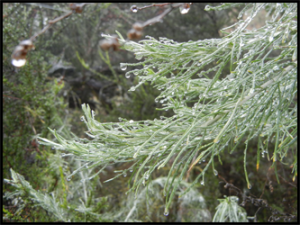
Emery, N. 2016. Foliar uptake in coastal California shrub species. Oecologia. 182(3), 731-742.
Emery, N. and J. Lesage*. 2015. Late summer fog use in the drought deciduous shrub, Artemisia californica (Asteraceae). Madroño, 150-157.
I have also explored foliar water uptake as an relatively unknown pathway for water to enter and be used by plants. Below is a figure I designed illustrating the pathways for foliar uptake of water through leaves.
Relevant publications:
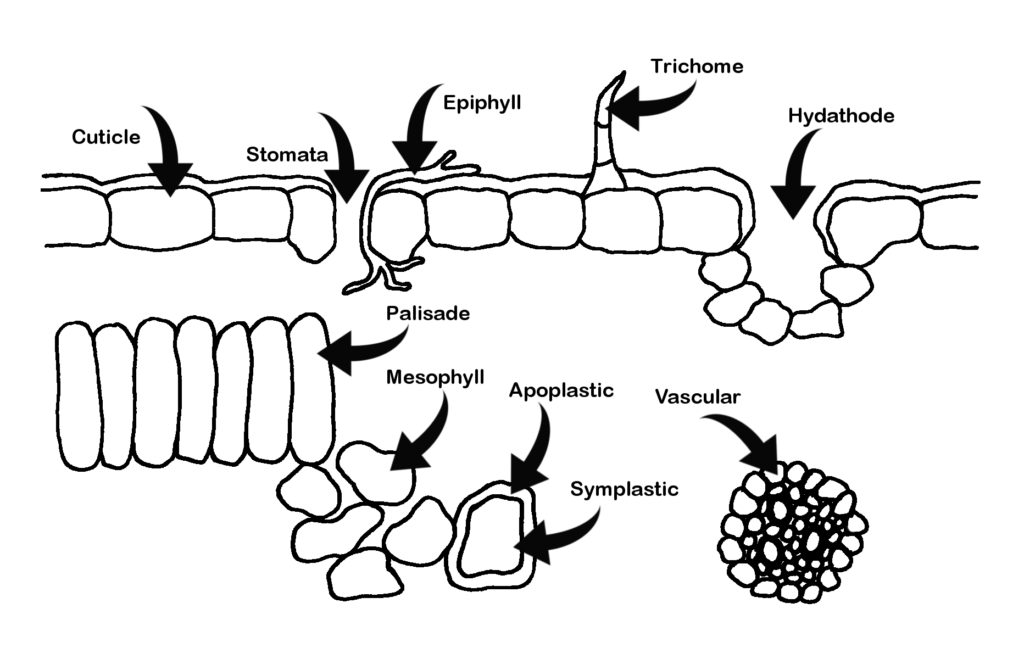
Berry, Z. C., Emery, N., Gotsch, S., and G. Goldsmith. 2019. Foliar water uptake: processes, pathways, and integration into plant water budgets. Plant, cell & environment, 42(2), 410-423.
What are the greater ecological implications of differential water use among plants?
As a plant ecologist I’m constantly thinking about complex systems in the natural world. Much of my research has focused on exploring plant water use in the context of fire ecology. Photo is from the 2015 Gibralter fire showing the recent fire scar and Phos-Chek used as fire retardant.
Relevant publications:
Ma, S., D’Antonio, C. M., and N. Emery. Effects of Short Interval Wildfires on Southern California’s Shrubland Communities. In review.
Emery, N., Roth, K., & Pivovaroff, A. L. 2020. Flowering phenology indicates plant flammability in a dominant shrub species. Ecological Indicators, 109, 105745.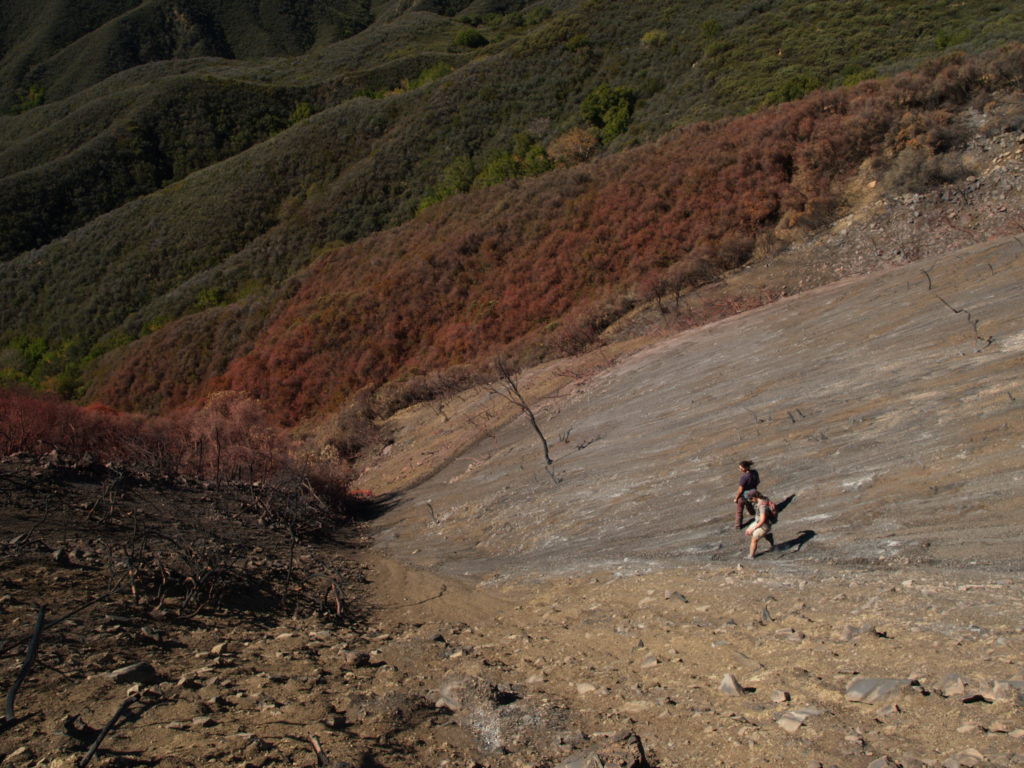 Pivovaroff, A. L., Emery, N., Sharifi, M. R., Witter, M., Keeley, J. E., & P. W. Rundel. 2019. The Effect of Ecophysiological Traits on Live Fuel Moisture Content. Fire, 2(2), 28.
Pivovaroff, A. L., Emery, N., Sharifi, M. R., Witter, M., Keeley, J. E., & P. W. Rundel. 2019. The Effect of Ecophysiological Traits on Live Fuel Moisture Content. Fire, 2(2), 28.
Emery, N., C. M. D’Antonio, and C. J. Still. 2018. Fog and live fuel moisture in coastal California shrublands. Ecosphere, 9(4)
Chen, X., Emery, N., Garcia, E. S., Hanan, E. J., Hodges, H. E., Martin, T., … & Tague, C. 2013. Perspectives on disconnects between scientific information and management decisions on post-fire recovery in western US. Environmental management, 1-12.
How can we effectively prepare instructors to teach student-focused courses and implement scientific teaching practices in the classroom?
During my career I have come to recognize the importance of evidence-based teaching and taking a student-focused approach to my courses. This led me to a postdoc at Michigan State University examining teaching professional development for early-career biology faculty. My co-authors and I are in the process of writing up three more publications from this NSF-funded project. While at MSU, I also had the opportunity to lead a paper outlining best-practices in mentoring for undergraduate research projects.
Relevant publications:
Emery, N., Bledsoe, E., and A. Hasley. 2020. Cultivating inclusive educational and research environments in ecology and evolution. Ecology & Evolution
Emery, N., Maher, J. M., and D. Ebert-May. 2020. Early-career faculty practice learner-centered teaching up to 9 years after postdoctoral professional development. Science Advances 6, eaba2091
Ålund, M.†, Emery, N. †, Jarrett, B. J., MacLeod, K. J., McCreery, H. F., Mamoozadeh, N., … and E. B. Gering. 2020. Academic ecosystems must evolve to support a sustainable postdoc workforce. Nature Ecology & Evolution, 1-5. †Authors contributed equally
Emery, N. C., Maher, J. M., & Ebert-May, D. 2019. Longitudinal study of persistence in professional development outcomes of early career biology faculty. bioRxiv, 785857.
Emery, N., Maher, J. M., and D. Ebert-May. 2019. Professional Development in STEM Higher Education: Studying the Educational Ecosystem. Innovative Higher Education 1-11.
Emery, N., Hund, A., Burks, R., Duffy, M., Scoffoni, C., and A. Swei. 2019. Students as ecologists: Strategies for successful mentorship of undergraduate researchers. Ecology and Evolution, 9: 4316–4326
Ebert-May, D. and N. Emery. 2017. Teaching like a scientist: assessing your assessments. Frontiers in Ecology and the Environment, 15(5), 227-227.
Publications List
* denotes undergraduate coauthor
Google Scholar Profile
Behind a paywall? Email me at emeryna1 [at] msu [dot] edu for reprints
Emery, N., Bledsoe, E., and A. Hasley. 2020. Cultivating inclusive educational and research environments in ecology and evolution. Ecology & Evolution
Emery, N., Maher, J. M., and D. Ebert-May. 2020. Early-career faculty practice learner-centered teaching up to 9 years after postdoctoral professional development. Science Advances 6, eaba2091
Ålund, M.†, Emery, N. †, Jarrett, B. J., MacLeod, K. J., McCreery, H. F., Mamoozadeh, N., … and E. B. Gering. 2020. Academic ecosystems must evolve to support a sustainable postdoc workforce. Nature Ecology & Evolution, 1-5. †Authors contributed equally
Emery, N., Roth, K., & Pivovaroff, A. L. 2020. Flowering phenology indicates plant flammability in a dominant shrub species. Ecological Indicators, 109, 105745.
Emery, N. C., Maher, J. M., & Ebert-May, D. 2019. Longitudinal study of persistence in professional development outcomes of early career biology faculty. bioRxiv, 785857.
Emery, N., Maher, J. M., and D. Ebert-May. 2019. Professional Development in STEM Higher Education: Studying the Educational Ecosystem. Innovative Higher Education 1-11.
Emery, N., Trujillo, C., Jarosz, A., and T. Long. 2019. Quantifying and Visualizing Campus Tree Phenology. CourseSource.
Emery, N., Hund, A., Burks, R., Duffy, M., Scoffoni, C., and A. Swei. 2019. Students as ecologists: Strategies for successful mentorship of undergraduate researchers. Ecology and Evolution, 9: 4316–4326
Pivovaroff, A. L., Emery, N., Sharifi, M. R., Witter, M., Keeley, J. E., & P. W. Rundel. 2019. The Effect of Ecophysiological Traits on Live Fuel Moisture Content. Fire, 2(2), 28.
VanWallendael, A., Soltani, A., Emery, N. C., Peixoto, M. M., Olsen, J., & D. B. Lowry. 2019. A Molecular View of Plant Local Adaptation: Incorporating Stress-Response Networks. Annual review of plant biology, 70.
Berry, Z. C., Emery, N., Gotsch, S., and G. Goldsmith. 2019. Foliar water uptake: processes, pathways, and integration into plant water budgets. Plant, cell & environment, 42(2), 410-423.
Emery, N., C. M. D’Antonio, and C. J. Still. 2018. Fog and live fuel moisture in coastal California shrublands. Ecosphere, 9(4)
Ebert-May, D. and N. Emery. 2017. Teaching like a scientist: assessing your assessments. Frontiers in Ecology and the Environment, 15(5), 227-227.
Emery, N. 2016. Foliar uptake in coastal California shrub species. Oecologia. 182(3), 731-742.
Emery, N. 2016. Writing an Ecology Research Proposal. EcoEd Digital Library. Ecological Society of America.
Emery, N. and J. Lesage*. 2015. Late summer fog use in the drought deciduous shrub, Artemisia californica (Asteraceae). Madroño, 150-157.
Chen, X., Emery, N., Garcia, E. S., Hanan, E. J., Hodges, H. E., Martin, T., … & Tague, C. 2013. Perspectives on disconnects between scientific information and management decisions on post-fire recovery in western US. Environmental management, 1-12.
Elseroad, A.; Emery, N. and L. Nelson. 2009. Changes in vegetation on range monitoring plots at Naval Weapons Systems Training Facility (NWSTF) Boardman from 1987-2008. Technical Report, The Nature Conservancy.
Elseroad, A. and N. Emery. 2009. Changes in vegetation at Lawrence Memorial Grasslands Preserve from 1993-2008. Technical Report, The Nature Conservancy.
Publications in progress
Ma, S., D’Antonio, C. M., and N. Emery. Effects of Short Interval Wildfires on Southern California’s Shrubland Communities. In prep.
Alund, M.†, Emery, N.†… and E. Gering. A clear and sustainable vision for training the growing postdoctoral workforce. In Review (†Co-first author)
Emery, N., Pivavoroff, A., and K. Roth. Flowering phenology predicts plant flammability. In Review.
Lott, S.* and N. Emery. Leaf morphological traits affect hydrophobicity. In Review.


 Pivovaroff, A. L., Emery, N., Sharifi, M. R., Witter, M., Keeley, J. E., & P. W. Rundel. 2019. The Effect of Ecophysiological Traits on Live Fuel Moisture Content. Fire, 2(2), 28.
Pivovaroff, A. L., Emery, N., Sharifi, M. R., Witter, M., Keeley, J. E., & P. W. Rundel. 2019. The Effect of Ecophysiological Traits on Live Fuel Moisture Content. Fire, 2(2), 28.
